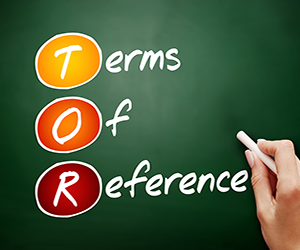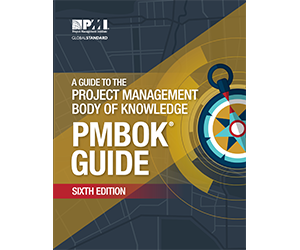
The Terms of Reference (TOR) is a description of the technical work involved in a project, or part of a project. Specifically, it is used to specify the work required by an external consultant, contractor, or supplier.
It is the technical part of the bidding documents.
Typically, a project manager develops a Terms of Reference which is included within the bidding documents for the vendor, and subsequently becomes a part of the contract.
A strong Terms of Reference contains the following information:
- Scope of Work
- Schedule
- Coordination requirements
- Laws, regulations, and standards
- Resources provided
Scope of Work
This is derived from the project scope statement, and contains two main components:
 Deliverables
Deliverables
The word deliverables is not in the english dictionary and is underlined in MS Word as a spelling mistake, but it is one of the most important words in project management. Deliverables are those items the project has been commissioned to produce. They can be a tangible product, such as a building, or an electronic item such as a database. They can also be services, for example a training course. But every project has been created to produce something, and those products must be well defined.The deliverables must be defined in terms of grade and quality. Grade is the product’s classification based on technical characteristics, versus quality which is the degree to which the product fulfills requirements. Low grade is not a bad thing, as long as it was intended to be so. Low quality, however, means the product did not fulfill its requirements and is always a bad thing. The Project Management Body of Knowledge (PMBOK) specifies the creation of a quality management plan, part of the overall project management plan, where the requirements are defined prior to project execution. The Terms of Reference are usually a document that contains verbiage only, that is, it does not include drawings and plans.
In the construction industry, the Terms of Reference are applied to the engineering, architecture, and design trades rather than the builder (contractor). It contains a listing of project requirements, such as preliminary reports, design reports, and drawing review requirements. Once the service provider has been chosen, the builder (contractor) is chosen via an Invitation to Tender, which includes the full design drawings and specifications.
- Tasks
Usually the Terms of Reference contain a listing of tasks required. This can significantly elaborate on the deliverables by ensuring the vendors understand the tasks that are required to produce the deliverables.Although a competent vendor should be able to decompose the deliverables into constituent tasks, a predetermined task list ensures that less competent vendors do not miss something and thereby underbid the more competent vendors.In the PMBOK Guide, the deliverables are specified in a Work Breakdown Structure (WBS), which is then decomposed into an activity list. Both of these items are solid parts of a Terms of Reference.
Schedule
 Schedules are to a project manager like hammers are to a carpenter. If you have a strong scope of work but no timeline to perform it under, you might get excellent work in an unacceptable time line.
Schedules are to a project manager like hammers are to a carpenter. If you have a strong scope of work but no timeline to perform it under, you might get excellent work in an unacceptable time line.
Hence, Terms of Reference should have a schedule that details the major milestones. Whether a full gantt chart with completion dates for each and every task, or a listing of a few project milestones, it gives the vendor a firm schedule to perform the work under.
Typically, a simple table itemizing the major project milestones establishes the schedule baseline without micromanaging an external supplier.
Coordination Requirements
Often the work must be coordinated with third parties. These could include utility companies, environmental monitoring agencies, database management firms, or other third party stakeholders that overlap with the project.
It is rare these days that a project does not have some form of overlap with third party stakeholders. Adjacent landowners, end users, or even the general public must be actively managed to ensure they do not trip up the project.
It is easy to identify the major stakeholders that have large power over, or interest in, the project. But it’s usually the minor ones, who aren’t as obvious who trip up a project when they feel they haven’t been consulted.
The Terms of Reference should clearly list the third parties that have an interest in the project, and define what their interest is as much as possible.
Laws, Regulations, and Standards
 Likewise, it is rare these days that a project does not have some form of government regulations that must be adhered to and/or permits obtained.
Likewise, it is rare these days that a project does not have some form of government regulations that must be adhered to and/or permits obtained.
Government regulatory agencies are not in the business of stopping projects. Rather, they seek to balance the needs of a stakeholder group, for example an environmental activist group, with the needs of the project. Of course, they have the power to rule completely in one direction. But typically they allow projects to proceed under a set of requirements which was determined from consultations with the other side. And these requirements often have cost and schedule implications to the project.
In the same way, almost every industry has standards that have been developed for different types of work. The International Standards Organization (ISO) has developed standards for many things, but most countries have their own standards organizations that have expanded on and adapted the ISO standards, for example the American National Standards Institute (ANSI). In addition, industry specific standards organizations produce highly focused standards, such as the American Society for Testing and Materials (ASTM).
Unless the work is innovative or cutting edge, it is a safe bet that a strong industry-adopted standard can be specified within the Terms of Reference that gives the owner comfort in the quality of work being performed.
Resources Provided
Often the vendor requires resources from the owner to complete the work specified within the Terms of Reference. This can include databases, facilities, or access to work sites. It can include past evaluation data for similar work.
This is an area that, in my experience, has some significant room for improvement. Typically, owner organizations possess quite a bit of information that might assist a contractor, but they do not think very hard about what a contractor might need to do their work better or faster. Hence, it doesn’t get passed on to the contractor and the contractor does not ask unless it results in large increases in time or cost. The result is that easy ways to save money are neglected.
The Project Management Body of Knowledge (PMBOK Guide)
 In the PMBOK Guide, the Procurement Statement of Work is an output of the Plan Procurement Management process within the Project Procurement Management knowledge area.
In the PMBOK Guide, the Procurement Statement of Work is an output of the Plan Procurement Management process within the Project Procurement Management knowledge area.
The Terms of Reference is identical to this Procurement Statement of Work. The PMBOK Guide prefers the more generic Statement of Work because Terms of Reference is used predominantly in certain industries and very little in others.
It is located within the Project Planning process group, hence it is produced prior to the execution phase of the project.






